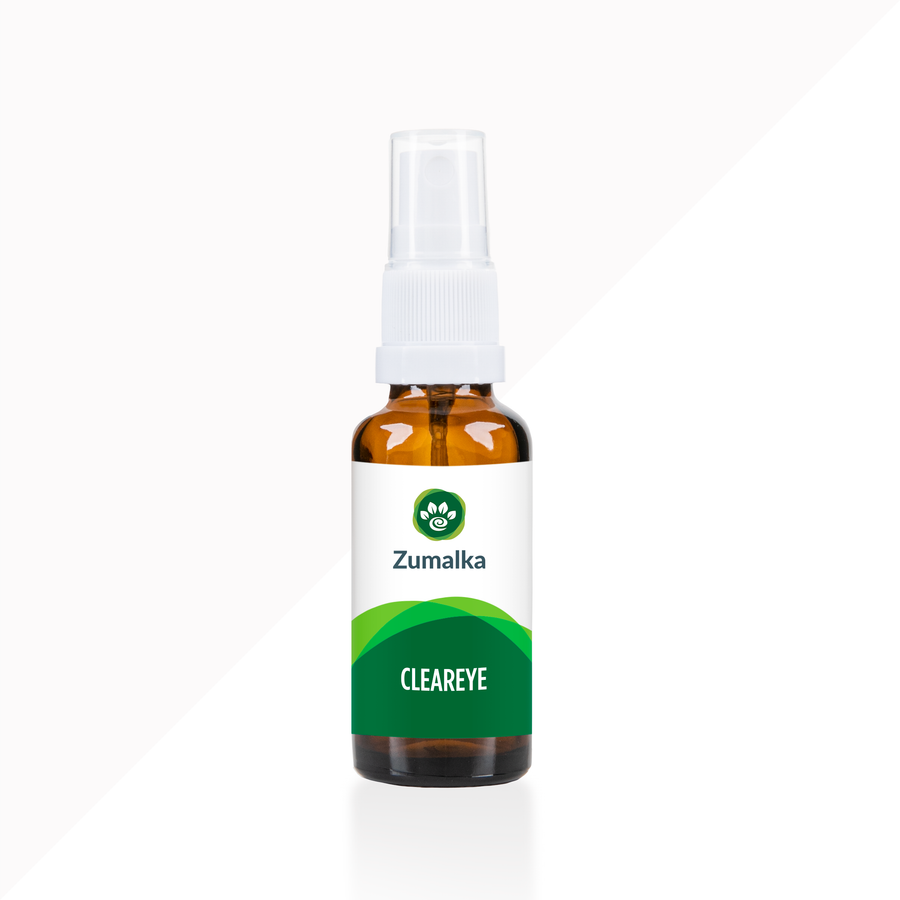Conjunctivitis in Cats: Vet-Verified Causes, Symptoms & Effective Treatments
List of Contents
- What is Conjunctivitis in Cats?
-
Feline Conjunctivitis vs. Cat Eye Infections
-
What are the Clinical Signs of Cat Conjunctivitis?
-
What Causes Conjunctivitis in Cats?
-
How is Conjunctivitis in Felines Diagnosed?
-
How is Conjunctivitis in Cats Treated?
-
Can You Treat Cat Pink Eye Naturally?
-
How Do You Prevent Cat Conjunctivitis?
- FAQs
Conjunctivitis in cats is a common condition that’s easy to treat—and even easier to prevent. As a holistic veterinarian, I’ll walk you through everything you need to know, from its causes and symptoms to the most effective treatments.
What is Conjunctivitis in Cats?
Also known as "cat pink eye," feline conjunctivitis is a common eye condition in cats. Rather than a disease itself, it’s a symptom of inflammation in the conjunctiva—also called the "third eyelid"—the thin mucous membrane that covers the eye and inner eyelids.
When the third eyelid becomes inflamed or irritated, your cat’s eyes may become weepy, with excessive discharge and redness. As the irritation worsens, you might also notice your cat squinting or rubbing their face.
This condition can have multiple causes, including secondary bacterial infections, feline viral rhinotracheitis (herpes virus), and allergies.
Many mistakenly believe "only sickly cats" get feline conjunctivitis, but even healthy cats can be affected, often contracting it from viral infections or similar sources.
Feline Conjunctivitis vs. Cat Eye Infections
Understanding the difference between inflammation—such as in feline conjunctivitis—and infection is key to managing your cat’s eye health.
Inflammation is the body's natural response to irritation, whereas infections occur when bacteria or viruses invade tissue. Bacterial infections often accompany viral ones, such as feline immunodeficiency virus, making it essential to identify the root cause.
Mild, non-bacterial conjunctivitis can often be managed at home with gentle eye cleaning and minimizing environmental irritants. However, if symptoms worsen or signs of infection appear—such as thick discharge, swelling, or persistent discomfort—consulting a veterinarian is best.
Prompt care helps prevent complications and ensures your cat’s long-term eye health.
What are the Clinical Signs of Cat Conjunctivitis?

Compared to other feline health issues, conjunctivitis is often easy to recognize. Look for these key signs and symptoms:
- Redness and swelling: Whites of the eyes and inner eyelids appear red or puffy.
- Discharge: Clear, yellow, green, or thick mucus-like eye discharge.
- Squinting and blinking: Excessive blinking or squinting due to discomfort.
-
Pawing at the eyes: Rubbing eyes with paws or against surfaces.
- Cloudiness: Cornea may appear hazy in severe cases.
- Third eyelid visibility: The nictitating membrane may be more prominent.
- Excessive tearing: Increased tear production or watery eyes.
- Light sensitivity: Avoiding bright light or keeping eyes closed.
- Crusting: Dried discharge around the eyes.
- Respiratory symptoms: Sneezing or nasal discharge if related to an infection.
I’d like to highlight that many cat owners overlook feline conjunctivitis, assuming it’s a minor irritation. However, consulting a vet is crucial, as even mild cases can worsen without proper care.
What Causes Conjunctivitis in Cats?
The causes of conjunctivitis in cats can be grouped into two categories: infectious agents and non-infectious agents.
Cat conjunctivitis caused by infectious agents
Common causes of infectious conjunctivitis in cats include feline herpesvirus, often associated with upper respiratory tract disease (URD), and chlamydia, a highly contagious bacterial infection most prevalent in the summer months.
Feline calicivirus can also be a culprit, causing both oral infections and upper respiratory issues. Cats with feline leukemia virus (FeLV) or feline immunodeficiency virus (FIV) may also be at higher risk. Additionally, reddening of the conjunctival membranes may indicate feline eye tumors.
Cat conjunctivitis caused by non-infectious agents
On the other hand, pink eye in cats can also result from breed-specific or hereditary predispositions, leading to hypersensitivity or an overactive immune response.
Environmental factors like pollen, food allergies, dust, mold, foreign bodies, smoke, strong fragrances, and household chemicals can cause irritation and inflammation, potentially worsening symptoms over time.
Essential fact about infected cats
Did you know? Cats that recover from infection often remain lifelong carriers. Stress can trigger reinfection, so maintaining a calm environment and supporting their immune system is essential.
How is Conjunctivitis in Felines Diagnosed?

A presumptive diagnosis of conjunctivitis in cats is based on characteristic clinical signs and a history of potential exposure to bacteria or viruses. The process begins with a thorough physical examination and a review of the patient’s medical history.
For example, if an owner brings in a kitten with conjunctivitis, my first question is where the kitten came from. If it’s from a rescue or boarding facility, there’s a high chance it has contracted cat flu, as these environments are often overcrowded and stressful, increasing the risk of infection.
If respiratory symptoms like sneezing and wheezing are present, I take nasal swabs of the discharge and send them to the lab for isolation, culture, or polymerase chain reaction (PCR) testing.
How is Conjunctivitis in Cats Treated?
As mentioned, viruses and bacteria can coexist. When a virus weakens the immune system, opportunistic bacteria like chlamydia and mycoplasma can cause infections requiring antibiotic treatment.
Dealing with cat conjunctivitis using antibiotics
For severe eye infections and conjunctivitis in cats, I typically prescribe a 7-day course of doxycycline. This antibiotic is secreted through the tear ducts, coating the eye to promote healing while also targeting infectious agents like mycoplasma.
Pain relief and conjunctivitis in cats
Did you know that feline herpes virus can cause a corneal ulcer in the affected eye, leading to significant pain? In such cases, I typically prescribe a non-steroidal anti-inflammatory drug (NSAID) for pain relief. NSAIDs can also help reduce fever, which often accompanies severe conjunctivitis in cats.
Can You Treat Cat Pink Eye Naturally?

If your cat has non-infectious conjunctivitis, there are several ways you can help at home to support a speedy recovery. Here are my top natural remedies for this condition:
- Use a warm compress: If your cat has excessive eye discharge, gently clean the eye with warm water. Soak a cotton swab and wipe the area once or twice daily.
- Steam therapy for cat conjunctivitis: Bring your cat into the bathroom while running a hot shower to create steam—no bathing required. This may open airways, hydrate, and loosen mucus for added comfort. Ensure your cat stays calm and avoid excessive heat.
- Ensure your cat stays hydrated: Treat feline conjunctivitis like the flu—fluids are key to recovery. If your cat isn’t drinking much water, offer more wet food, which provides both nutrition and over 80% water content. You can also try flavored broths or a pet-safe electrolyte solution.
- Topical medications and lubricating eye drops for feline pink eye: If your cat's conjunctivitis is due to pollen or allergies, apply human-grade lubricating eye drops to help reduce inflammation and irritation associated with allergic conjunctivitis.
- Consider using Zumalka's CLEAREYE: CLEAREYE is a premium natural product formulated to support eye health, reduce inflammation, and nourish eye tissues in pets. It contains Apis mellifica, a bee venom extract known for its anti-inflammatory properties.
If you’re exploring natural remedies to keep your cat healthy, consult a pet homeopathy expert for guidance. However, this should not replace regular veterinary consultations. Early detection is crucial in addressing health issues in cats.
How Do You Prevent Cat Conjunctivitis?
Cat pink eye is a common but preventable health issue.
Regularly cleaning your cat’s eyes, along with vaccinating against feline herpesvirus (FHV-1) and calicivirus, can significantly reduce the risk of infection. These steps help strengthen your cat’s immune defenses against bacterial and viral threats, keeping their eyes healthy and irritation-free.
To further prevent feline conjunctivitis, address underlying health concerns, reduce environmental irritants, control parasites, and limit exposure to infected cats. Additionally, regularly disinfecting food bowls, bedding, and litter boxes, as well as washing your hands after handling an infected cat, is crucial for minimizing the spread of infection.
FAQs
How do you treat conjunctivitis in cats?
Treat feline conjunctivitis by gently cleaning their eyes, using vet-prescribed drops or antibiotics, addressing underlying causes, and reducing irritants. Isolate infected cats and maintain hygiene to prevent the spread.
Can cat conjunctivitis spread to humans?
Cat conjunctivitis is typically caused by feline-specific viruses or bacteria and rarely spreads to humans. However, certain bacteria like Chlamydia felis pose a slight risk. Practicing good hygiene and washing hands after handling infected cats minimizes transmission.
Can conjunctivitis in cats clear up on its own?
Mild conjunctivitis may clear up on its own, but bacterial or severe cases need treatment. Maintaining hygiene, reducing irritants, and addressing underlying causes help prevent complications and promote faster healing.
What is the fastest way to cure cat conjunctivitis?
The fastest way to cure conjunctivitis is with proper diagnosis, vet-prescribed eye drops or antibiotics, and regular eye cleaning. Reducing irritants, maintaining hygiene, and treating underlying causes help speed recovery and prevent recurrence.
How long does conjunctivitis last?
Cat conjunctivitis usually lasts a few days to two weeks, depending on the cause and treatment. Mild cases resolve quickly, while severe or chronic infections need veterinary care for proper healing.







Hi Teresa, Thank you for your message and excellent question. I hope that this article has given you some good home tips to help your cat! We have also sent you private emails so that we can help your cat in a more personalized way.
We look forward to working with you!
Homeoanimal
Yes I don’t have the money right now to take my cat to the vet, in the meantime how should I treat his(Freds) eyes I would say he has an eye infection.?
The service was nice and helped me with my cat problems, the website is also very helpful.
Hi Stephanie, I am so sorry to hear about your cat’s eye lid issue. We are more than happy to find the most targeted help. We have sent you a private email to help out more.
Warm regards,
Homeoanimal
Thank you ❤️
Leave a comment